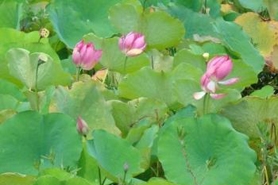Sacred Lotus
(Nelumbo nucifera)
A very showy perennial aquatic plant native to the warmer regions of Asia. It is considered invasive due to the large, dense colonies it can produce if released into natural areas from cultivation.
Other names for this plant include:
- Common names: Asian lotus, Indian lotus
- Scientific names: Nelumbium speciosum, Nelumbo speciosa, Nelumbium nelumbo
Classification in Wisconsin: Prohibited
- Ecological Threat
-
- Dense mats of floating vegetation can inhibit other native aquatic vegetation, decreasing biodiversity.
- It can affect other wildlife by blocking access to the water and reducing plants the animals depend on for shelter and nesting.
- The dense floating mats of vegetation can negatively affect boating, angling and swimming.
- Identification
-
Leaves: Medium to blue-green leaves float or are held above the water. They are hairless with smooth edges that may undulate up and down. Leaves are large and showy, one-half to three feet across with many radiating veins.
Flowers: Very showy flowers held up to six feet above the water. They have 12-15 pink petals with showy yellow stamens around a sizeable central receptacle. Flowers are four to eight inches across.
Fruits & seeds: The central seed pod remains after the short-lived flower blooms. It turns from green to brown, often used in dried floral arrangements. Individual seeds form in the pod and may stay viable for a long.
Roots: Thick rhizomes with fibrous roots; this plant can reproduce by rhizome and seed.
Similar species: Very similar to the American lotus (Nelumbo lutea), it can be distinguished by flower color; the American lotus has yellow flowers. Cultivars may have color variation, usually pale pink.
- Control
-
Mechanical: Tiny populations can be controlled by pulling. Physical removal should be completed before the flowering and seed set.
Chemical: Aquatic-approved herbicides may control populations. The application of aquatic herbicide will require a permit.
- Resources
- Sources for content:
- Illinois Wildflowers: factsheet [exit DNR]


